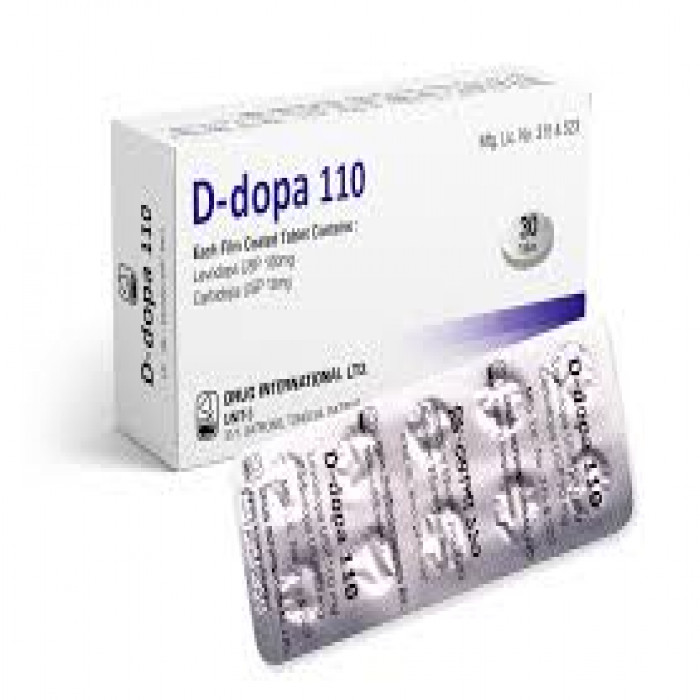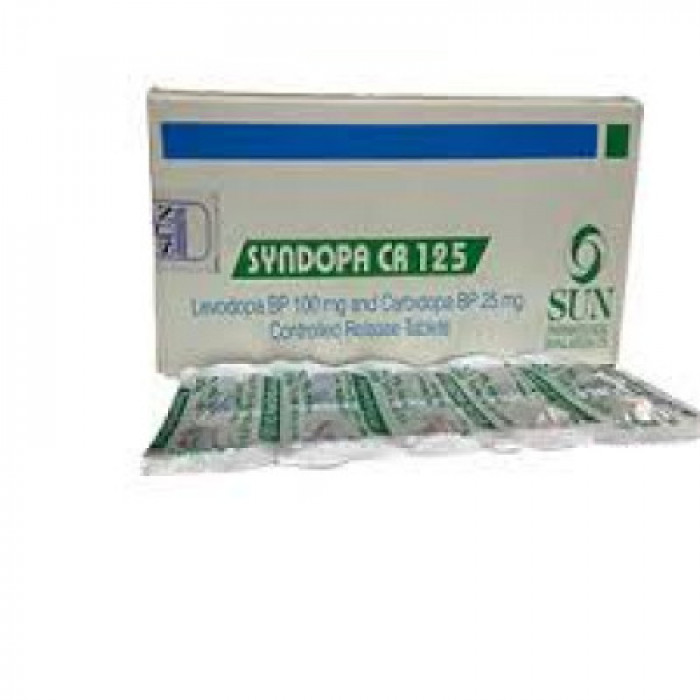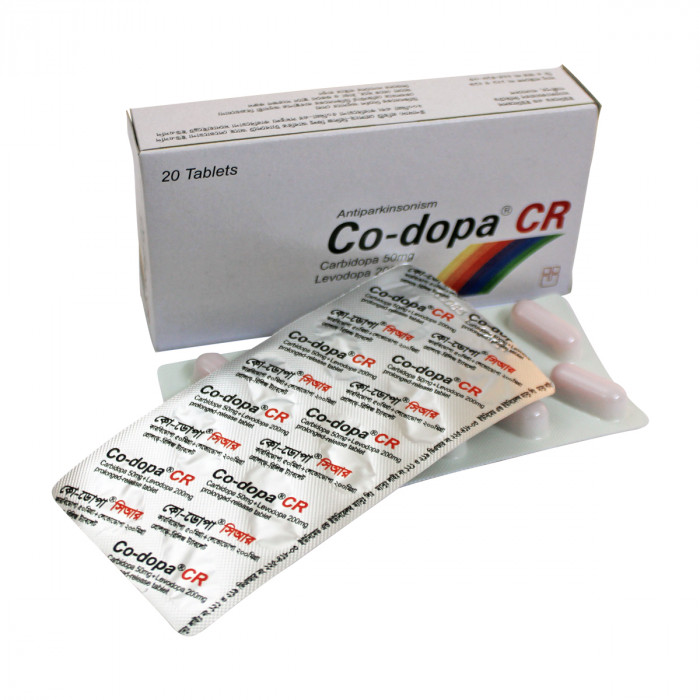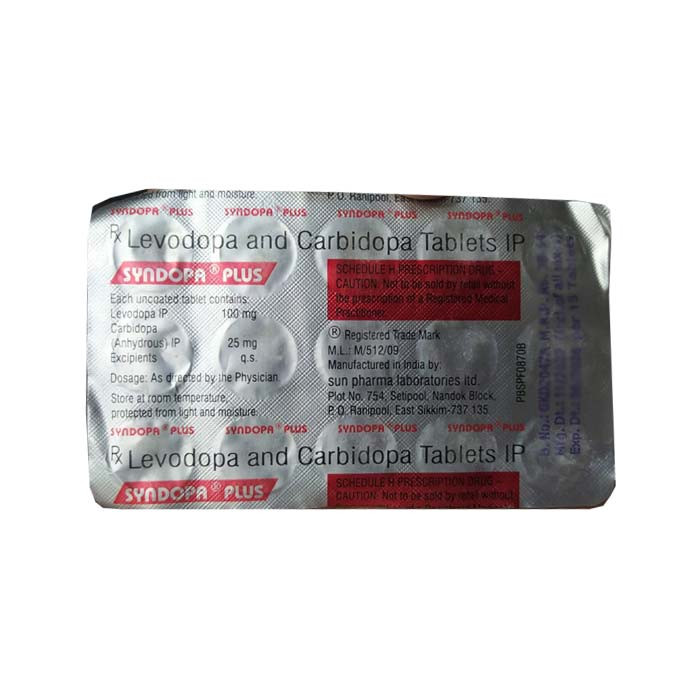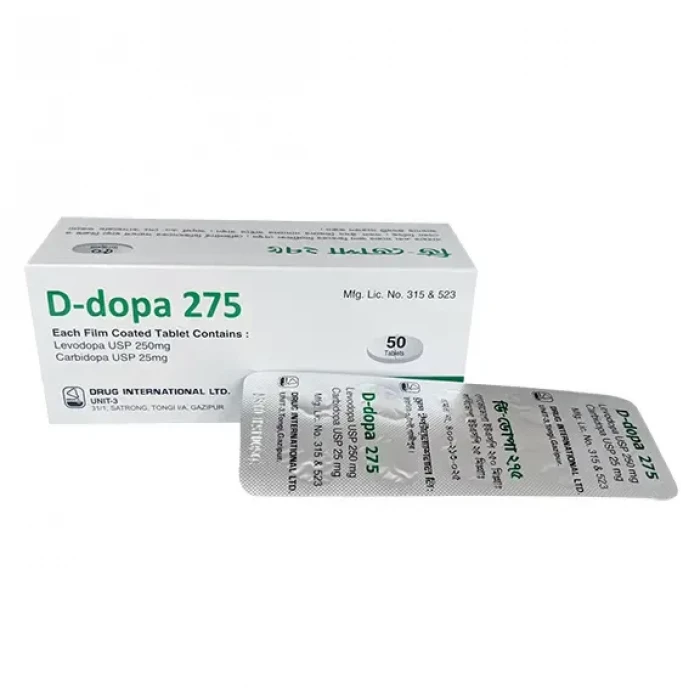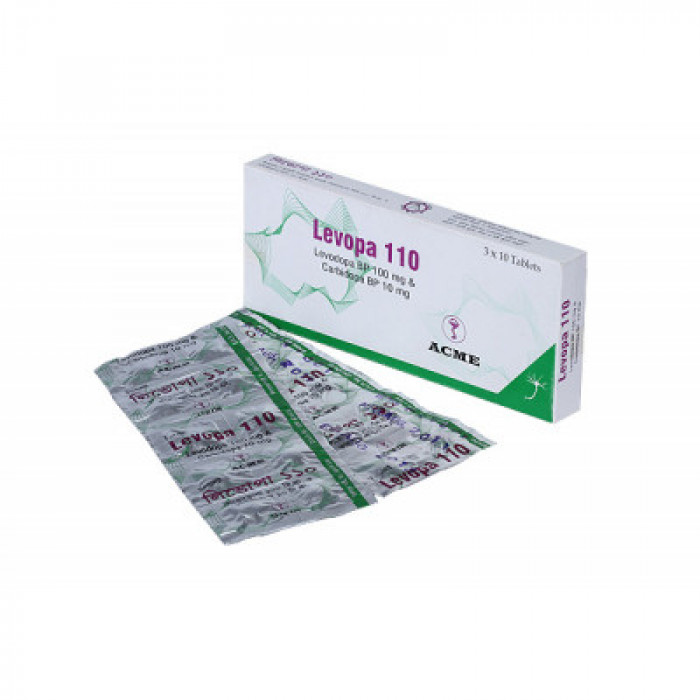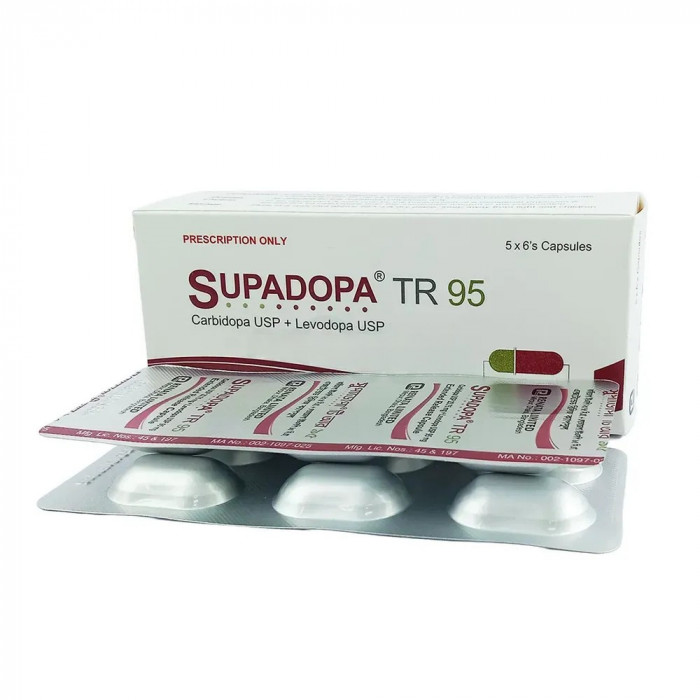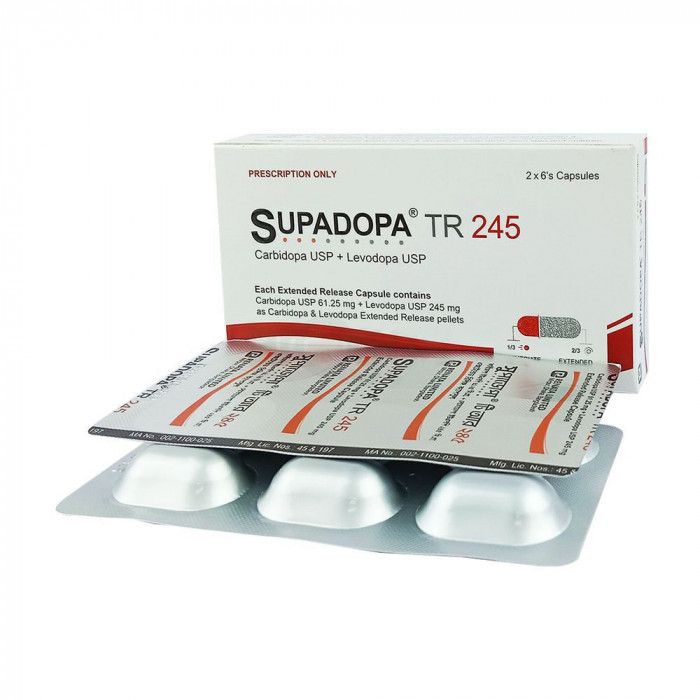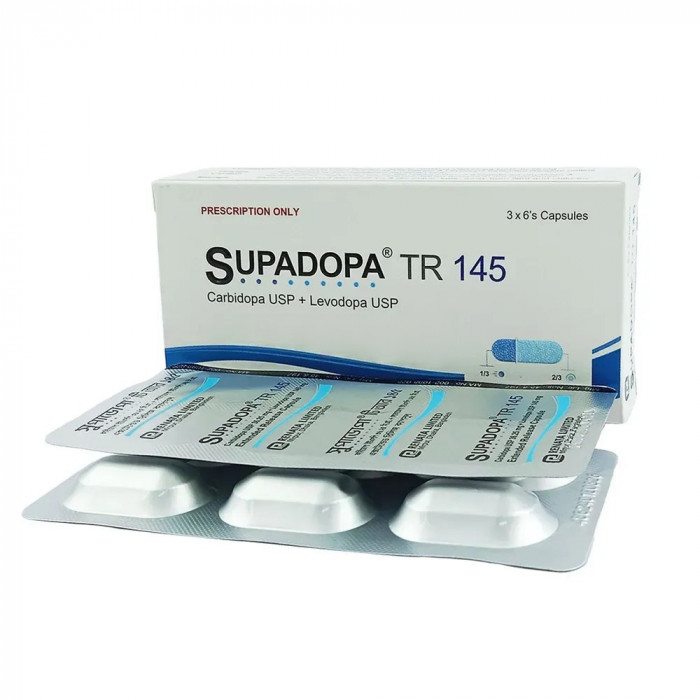
✔ 100% Authentic Product
👁️ Currently Viewing 2116
Supadopa TR 48.75mg+195mg Capsule
Supadopa TR is primarily prescribed for the treatment of Parkinson’s disease, a progressive neurodegenerative disorder characterized by tremors, rigidity, and bradykinesia (slowness of movement). Additionally, it is indicated for post-encephalitic parkinsonism, a condition that may arise as a consequence of viral encephalitis affecting the basal ganglia of the brain. Supadopa TR is also used in cases of parkinsonism induced by exposure to toxins, such as carbon monoxide poisoning or manganese intoxication.
Discount
Price: ৳ 294
MRP:
৳
300
2%
Off

100% Genuine Products, Guaranteed

Safe & Secure Payments, Always

Fast, Secure & Efficient Delivery

Proper Packaging
 Cash on Delivery - All over Bangladesh
Cash on Delivery - All over Bangladesh Regular Delivery - 12-24 Hours, Dhaka City* Charge Tk.39-59
Regular Delivery - 12-24 Hours, Dhaka City* Charge Tk.39-59 Regular Delivery - 24-48 Hours, Other Cities* Charge Tk.99-110
Regular Delivery - 24-48 Hours, Other Cities* Charge Tk.99-110
 ফ্রি ডেলিভারিঃ - ৯৯৯ টাকা+ অর্ডারে, ঢাকা
শহরে
ফ্রি ডেলিভারিঃ - ৯৯৯ টাকা+ অর্ডারে, ঢাকা
শহরে ফ্রি ডেলিভারিঃ - ২৯৯৯ টাকা+ অর্ডারে, ঢাকার
বাহিরে
ফ্রি ডেলিভারিঃ - ২৯৯৯ টাকা+ অর্ডারে, ঢাকার
বাহিরে
100% Genuine Products, Guaranteed
Safe & Secure Payments, Always
Fast, Secure & Efficient Delivery
Proper Packaging
 Cash on Delivery - All over Bangladesh
Cash on Delivery - All over Bangladesh Regular Delivery - 12-24 Hours, Dhaka City* Charge Tk.39-59
Regular Delivery - 12-24 Hours, Dhaka City* Charge Tk.39-59 Regular Delivery - 24-48 Hours, Other Cities* Charge Tk.99-110
Regular Delivery - 24-48 Hours, Other Cities* Charge Tk.99-110 ফ্রি ডেলিভারিঃ - ৯৯৯ টাকা+ অর্ডারে, ঢাকা
শহরে
ফ্রি ডেলিভারিঃ - ৯৯৯ টাকা+ অর্ডারে, ঢাকা
শহরে ফ্রি ডেলিভারিঃ - ২৯৯৯ টাকা+ অর্ডারে, ঢাকার
বাহিরে
ফ্রি ডেলিভারিঃ - ২৯৯৯ টাকা+ অর্ডারে, ঢাকার
বাহিরে
✅ Description:
Levodopa:
Levodopa serves as a metabolic precursor to dopamine, a neurotransmitter that plays a crucial role in motor function. Since dopamine itself cannot cross the blood-brain barrier (BBB), levodopa is administered as it is capable of entering the brain, where it is then converted into dopamine. The increase in dopamine levels helps in alleviating the motor symptoms associated with Parkinson’s disease.
Carbidopa:
When levodopa is taken orally, a significant portion of it is prematurely converted to dopamine in peripheral tissues before reaching the brain, reducing its effectiveness. Carbidopa acts as a decarboxylase inhibitor, preventing the breakdown of levodopa in the periphery. This allows more levodopa to reach the brain, increasing its therapeutic effects while minimizing peripheral side effects such as nausea and vomiting.
✔️ Uses
Treatment of Parkinson
✔️ Dosage & Administration: For Patients Who Have Never Taken Levodopa Before:
- The initial recommended dose for patients new to levodopa therapy is 95 mg of Supadopa TR, taken three times a day for the first three days.
- From the fourth day onward, the dose may be increased to 145 mg three times daily, depending on the patient’s response and tolerance.
- Based on clinical response, the dosage can be further increased up to a maximum of 390 mg per dose, three times a day.
- If necessary, the dosing frequency can be adjusted from three times daily to five times daily, provided the patient tolerates the medication.
- The total maximum allowable daily dose of Supadopa TR is 2,450 mg.
- It is advisable to maintain the lowest effective dose to manage symptoms while minimizing adverse reactions such as dyskinesia and nausea.
✔️ Dosage & Administration: For Patients Switching from Immediate-Release Carbidopa-Levodopa to Supadopa TR:
- The dosage of Supadopa TR is not interchangeable on a 1:1 basis with immediate-release carbidopa-levodopa formulations.
- The total daily levodopa dose from immediate-release formulations should first be calculated before switching to Supadopa TR.
- The recommended conversion dosage is as follows:
| Levodopa Dose in Immediate Release | Equivalent Daily Dose in Supadopa TR | Dosing Schedule |
|---|---|---|
| 400 mg – 549 mg | 855 mg | 3 capsules (95 mg each) TID |
| 550 mg – 749 mg | 1140 mg | 4 capsules (95 mg each) TID |
| 750 mg – 949 mg | 1305 mg | 3 capsules (145 mg each) TID |
| 950 mg – 1249 mg | 1755 mg | 3 capsules (195 mg each) TID |
| ≥ 1250 mg | 2340 mg or 2205 mg | 3 capsules (245 mg each) TID |
- Patients who are already taking a catechol-O-methyl transferase (COMT) inhibitor (such as entacapone) may require a higher initial levodopa dose when switching to Supadopa TR.
- The use of Supadopa TR in combination with other levodopa formulations has not been studied and is therefore not recommended.
✔️ Drug Interactions:
Iron supplements and dopamine D2 receptor antagonists (such as metoclopramide) may reduce the effectiveness of Supadopa TR.
✔️ Contraindications:
- Supadopa TR must not be used in patients currently taking nonselective monoamine oxidase (MAO) inhibitors (such as phenelzine or tranylcypromine).
- A minimum gap of two weeks must be maintained after discontinuing an MAO inhibitor before starting Supadopa TR, as concurrent use may lead to hypertensive crises.
✔️ Possible Side Effects:
The side effects of Supadopa TR vary depending on the stage of Parkinson’s disease.
In Early-Stage Parkinson’s Disease:
The most commonly reported adverse effects (incidence ≥5%) include:
- Nausea
- Dizziness
- Headache
- Insomnia
- Abnormal dreams
- Dry mouth
- Dyskinesia (involuntary movements)
- Anxiety
- Constipation
- Vomiting
- Orthostatic hypotension (drop in blood pressure upon standing)
In Advanced-Stage Parkinson’s Disease:
The most frequently reported side effects in advanced Parkinson’s disease patients, when compared to immediate-release carbidopa-levodopa, include:
- Nausea
- Headache
✔️ Use During Pregnancy & Lactation:
Pregnancy:
- There is insufficient clinical data regarding the safety of Supadopa TR during pregnancy.
- Animal studies have indicated that carbidopa-levodopa may cause developmental toxicity, including teratogenic effects at doses comparable to human usage.
- Supadopa TR should only be used during pregnancy if the potential benefits outweigh the risks.
Lactation:
- Levodopa has been found in human breast milk, whereas the presence of carbidopa is not well-documented.
- The effect of Supadopa TR on infants and breast milk production remains unclear. However, levodopa is known to suppress prolactin secretion, which may inhibit lactation.
- Caution is advised when prescribing this medication to breastfeeding mothers.
✔️ Patients taking Supadopa TR should be closely monitored for:
- Sudden onset of sleep during daily activities
- Withdrawal symptoms, including fever, rigidity, confusion, and autonomic instability
- Cardiovascular events, such as ischemia (restricted blood flow to the heart)
- Hallucinations and psychosis
- Impulse control disorders, including compulsive behaviors
- Dyskinesia (abnormal involuntary movements)
- Peptic ulcer disease
- Glaucoma (increased intraocular pressure)
✔️ Pediatric Use
- The safety and efficacy of Supadopa TR in children have not been established.
✔️ Storage:
- Store in a cool, dry place, away from moisture and direct sunlight.
- Keep out of reach of children to prevent accidental ingestion.
⚠️Disclaimer:
At ePharma, we’re committed to providing accurate and accessible health information. However, all content is intended for informational purposes only and should not replace medical advice from a qualified physician. Please consult your healthcare provider for personalized guidance. We aim to support, not substitute, the doctor-patient relationship.




